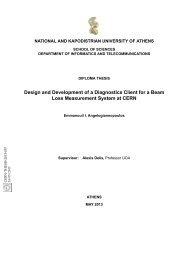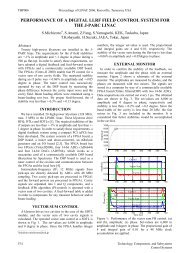Preliminary Ttcbi
Preliminary Ttcbi
Preliminary Ttcbi
Create successful ePaper yourself
Turn your PDF publications into a flip-book with our unique Google optimized e-Paper software.
LHC Project Document No.<br />
LHC-BI-ES-XXXX.XX rev 0.0 Draft<br />
16 D3 M_SAddr(0) : LSB of Message subadress writted into dual ported RAM<br />
17 D2 L_DoutStr : Data strobe from local message generator; Active H<br />
18 D1 L_Mess_Data(0): LSB of local message<br />
19 D0 LTC: Turn Clock correspondiing to the signal send to hardware connector<br />
20 GND<br />
JTAG header J2: To be used for downloading the FPGA configuration using a JTAG [11] port.<br />
Strap settings:<br />
Pin1 : GND Pin4 : TCK<br />
Pin2 : TDI Pin5 : TDO<br />
Pin3 : TMS Pin6 : VCC<br />
7. BOARD CONFIGURATION<br />
Page 12 of 18<br />
• ST2 : TTCrx configuration mode.<br />
PROM = Configuration downloaded from XC1736 PROM on power-on or TTC reset.<br />
NO PROM = Default configuration or downloaded from I2C bus or TTC commands.<br />
• ST3 : To perform a direct access to XCV50 JTAG[10] port. Used only for debugging.<br />
ON = bypass XC18V01 PROM in JTAG [10] chain.(For test only)<br />
OFF = Setting for normal use.<br />
• ST4 : PCI 9050 interface access control.<br />
ON = Enable PCI bus access ( Normal mode)<br />
OFF = Disable PCI bus access ( For test only)<br />
• ST5, ST6, ST7: XCV50 configuration mode M1, M0, M2 (see XILINX specifications.)<br />
ON OFF OFF = Configuration downloaded from JTAG[10] port J2.(For test only)<br />
ON ON ON = Configuration downloaded from XC18V01 flash PROM. (Default)<br />
The configuration is first downloaded into the PROM using the JTAG[10] port, then transferred to<br />
the XCV50 on next power-on, or by setting the reprogram bit of global control register.<br />
• ST8 : 3.3V power supply source according to the PCI specification [12].<br />
P3V3 = from PMC connector (if provided by mother board.)<br />
P3V3A = from on-board TPS767D325 regulator.<br />
8. MEMORY MAP<br />
All PCI accesses are 16 or 32 bits, using the 33MHz PCI clock with 128 Mbytes/sec block transfer<br />
capability. The PCI interface is constructed using a low price PCI 9050 target interface from PLX. [8]. As<br />
for all PCI devices, the TTCbi has 256 bytes of configuration space. System software may, on reboot,<br />
scan the configuration space to determine the device identification and parameters. One of the most<br />
important parameters is the base address, which maps the device into the PCI address space.<br />
The TTCbi uses 4 blocks of address space defined in the configuration register as follow:<br />
Block 0 : PLX Local Configuration registers mapped into 128 bytes of memory address space.<br />
Block 1 : PLX Local Configuration registers mapped into 128 bytes of I/O address space.<br />
Block 2 : FPGA internal registers and memories mapped into 1K bytes of memory address space.<br />
Block 3 : I2C interface registers mapped into 8 bytes of I/O address space.<br />
8.1 REGISTERS<br />
On power ON, the PCI 9050 registers are initialised using a serial EEPROM type National<br />
NM93CS46 and can be accessed in block 0 or 1.















